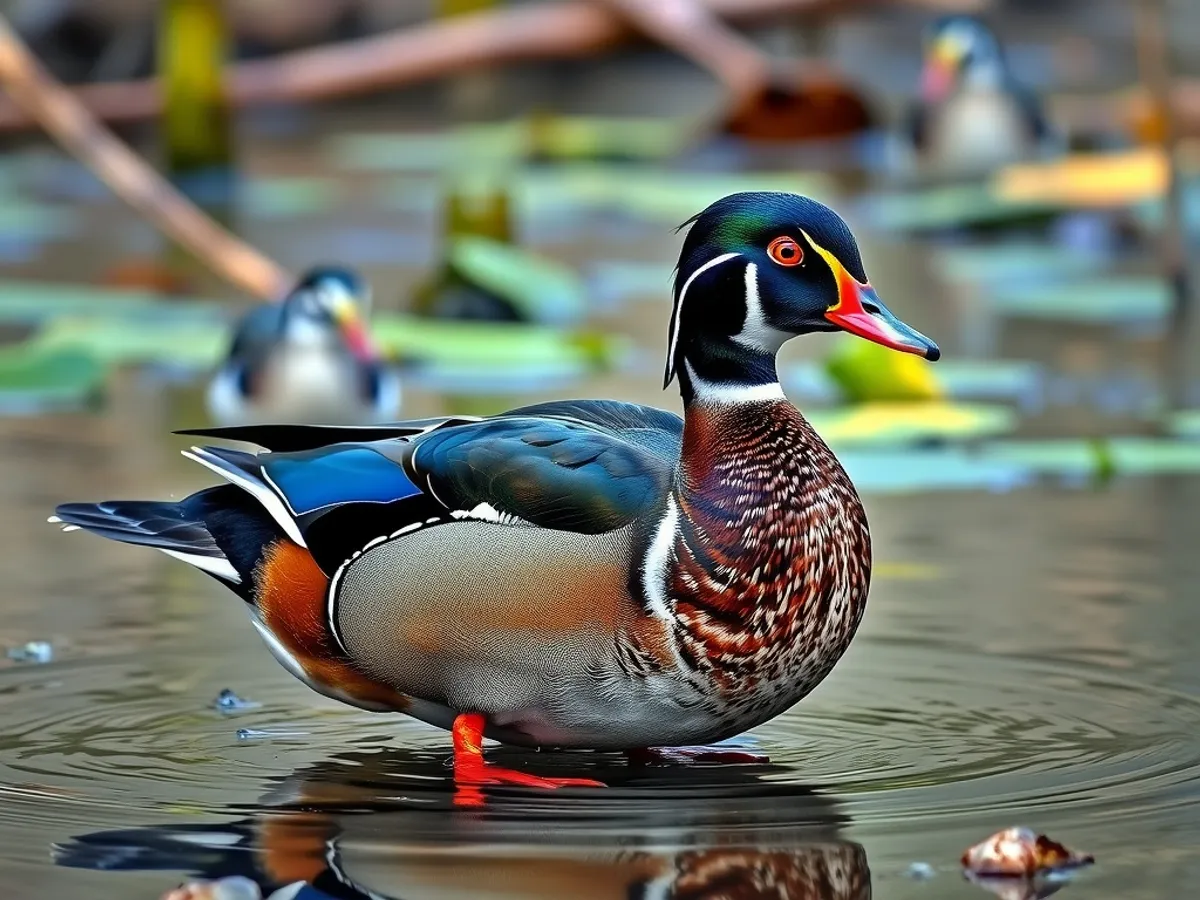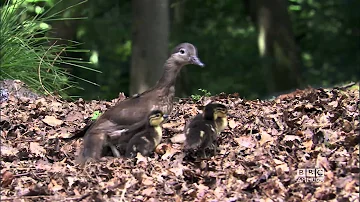
Wood Duck
Aix sponsa

Meet the Wood Duck
The Wood Duck is a strikingly colorful and medium-sized perching duck native to North America. Males are distinguished by their iridescent green and purple crests, red eyes, and ornate patterns, while females are more subtly colored with white eye rings and a gray-brown body. They are commonly found inhabiting wooded swamps, marshes, and streams, where they nest in tree cavities near water. Wood Ducks are renowned for their strong claws, which allow them to perch on branches, and their unique ability to take off vertically from water. Their populations have rebounded significantly due to successful conservation efforts and the widespread installation of nest boxes.
Classification
Bird
Habitat
Wooded swamps, marshes, streams, and forested wetlands
Diet
Omnivore
Lifespan
3-5 years in the wild
Conservation
Least Concern
Weight
454–862 grams
📖Fascinating Facts
Tree-Nesting Duck
Unlike most ducks, Wood Ducks commonly nest in tree cavities or nest boxes, often high above the ground or water.
Colorful Males
Male Wood Ducks are among the most colorful North American waterfowl, with iridescent green, purple, and chestnut feathers.
Daring Ducklings
Wood Duck ducklings leap from their nest up to 50 feet high within a day of hatching, bouncing safely to the ground before following their mother to water.
📋Detailed Description
The Wood Duck (Aix sponsa) is a medium-sized perching duck, measuring 47–54 cm (19–21 in) in length with a wingspan of 66–73 cm (26–29 in) and weighing 500–700 g (1.1–1.5 lbs). The male is renowned for its iridescent plumage, featuring a metallic green and purple crest, bold white throat stripes, chestnut breast, and red eyes, while the female is more cryptically colored with a gray-brown body, white-speckled breast, and a distinctive white teardrop-shaped eye ring. Both sexes possess strong, sharp claws adapted for perching on branches, a trait uncommon among ducks. The Wood Duck's bill is short and broad, aiding in foraging for a varied diet. Their vocalizations include high-pitched whistles and soft cooing, with females emitting a distinctive 'oo-eek' alarm call. Wood Ducks are agile fliers, capable of rapid vertical takeoff from water and adept maneuvering through dense forest canopies. They are primarily diurnal, foraging by dabbling and grazing in shallow water and on land. Social outside the breeding season, they form small flocks, but during breeding, pairs are territorial. Wood Ducks are cavity nesters, often utilizing natural tree hollows or artificial nest boxes, and ducklings exhibit remarkable precocial development, leaping from the nest cavity within 24 hours of hatching. Their distribution spans much of North America, with populations exhibiting partial migratory behavior, wintering in the southern United States and Mexico.
💡 Did you know?
Wood Duck ducklings are able to swim and find their own food just hours after hatching, even after leaping from heights of up to 15 meters (50 feet) to the forest floor.
🔬Research & Sources
Wikipedia Summary
The wood duck or Carolina duck is a partially migratory species of perching duck found in North America. The male is one of the most colorful North American waterfowls.
Last Modified: 5/25/2025
🎭Behavior & Social Structure
Wood Ducks display a complex array of behaviors, including strong site fidelity to breeding and wintering grounds. They are omnivorous, feeding on seeds, fruits (notably acorns and other mast), aquatic invertebrates, and insects, with diet composition shifting seasonally. Foraging occurs mainly in shallow water by dabbling, but they also graze on land, especially in the fall and winter. Socially, Wood Ducks are monogamous during the breeding season, with pairs forming in late winter. Outside of breeding, they may gather in loose flocks, especially during migration and on wintering grounds. They are wary and quick to flush when disturbed. Daily routines include early morning and late afternoon feeding, with midday periods spent loafing or preening on logs or branches over water. Wood Ducks are known for their agility in wooded habitats, often perching high in trees and moving through dense vegetation.
👶Reproduction & Life Cycle
Wood Ducks typically begin courtship in late winter, with pair bonds forming prior to arrival at breeding sites. Nesting occurs from March to July, peaking in April and May. Females select nest sites in tree cavities 1–15 m (3–50 ft) above ground or water, occasionally using nest boxes. Clutch size ranges from 6–16 eggs, with an average of 10–12. Incubation is performed solely by the female and lasts 27–37 days. Ducklings are precocial and leave the nest within 24 hours of hatching, leaping to the ground or water below, guided by the female's calls. Brood parasitism (egg dumping) is common, with females occasionally laying eggs in the nests of conspecifics. Only the female provides parental care, leading the ducklings to feeding areas, though the young feed themselves. Fledging occurs at 56–70 days post-hatch.
🛡️Adaptations & Survival
Wood Ducks exhibit several unique adaptations: strong, sharp claws for perching and climbing in trees; a flattened, broad bill for efficient dabbling and grazing; and cryptic female plumage for camouflage during nesting. Their eyes are positioned high on the head, providing a wide field of view to detect predators. Ducklings are highly precocial, covered in down and capable of coordinated movement and swimming immediately after hatching. The species' ability to nest in tree cavities is an evolutionary specialization, reducing nest predation compared to ground-nesting ducks. Their rapid vertical takeoff and maneuverability are crucial for escaping predators in forested habitats.
🎨Cultural Significance
The Wood Duck holds a prominent place in North American natural history and culture. Its striking appearance has made it a favorite subject among wildlife artists, birdwatchers, and hunters. The species is a symbol of successful conservation, often cited in environmental education. In some Native American traditions, ducks symbolize resourcefulness and adaptability. Wood Ducks are also popular in aviculture and have been featured on postage stamps and state conservation emblems. Their recovery story is frequently referenced as a model for collaborative conservation between government agencies, hunters, and the public.
🔬Recent Research & Discoveries
Recent research has focused on Wood Duck reproductive ecology, particularly the impacts of nest box density and placement on breeding success and brood parasitism rates. Studies using radio telemetry and stable isotope analysis have provided insights into migratory connectivity and habitat use. Genetic studies have examined population structure and gene flow across the species' range. Ongoing research addresses the effects of climate change on breeding phenology and range shifts. Notably, Wood Ducks serve as a model species for studying the effects of environmental contaminants on avian reproduction and development.
🎥Wildlife Videos

The Wood Duck: One of the Most Unique Ducks You'll Ever See
Belonging to a very small genus called Aix, the wood ducks' only close relative is the mandarin duck of Asia. They are unique ...
Lesley the Bird Nerd

15 Most Beautiful Ducks On The Planet | Wildlife Documentary | BBTV Official
When you think of beautiful birds, ducks might not be the first that come to mind—but prepare to be amazed. Across the world's ...
BBTV Official

PLANET EARTH: INCREDIBLE FAMILIES - Exclusive Sneak Peek at World Premiere Special
Watch an exclusive sneak peek of the world premiere special PLANET EARTH: INCREDIBLE FAMILIES before its debut ...
BBC America

Wood Duck From Hatching to Maturation. Film 1. English Version 4K
Wood #Duck #hatching #jump #duckling #hollow #Wildlife #Photography #Documentary #high Park A STUDY OF WOOD DUCKS ...
Wildlife Documentaries, Beso Nikuradze

Brave Wood Ducklings Take 30-Foot Leap of Faith
A dozen wood ducklings have just hatched in their treetop nest. Next comes the hard part: each and every one will have to leap 30 ...
Smithsonian Channel

**AUSTRALIAN WOOD DUCK** A Short Informative Video | Mini Documentary | NATURE EXPOSED | EP9, S2
In this week's episode, we take a closer look at the Australian wood Duck. From colourations & patterns to diet and social ...
Nature Exposed
🌍Habitat Information
The Wood Duck typically inhabits Wooded swamps, marshes, streams, and forested wetlands environments. Wood Ducks have adapted to their environments with specialized features and behaviors.
Primary Habitat:
Wooded swamps, marshes, streams, and forested wetlands
More detailed habitat information will be available soon.
🛡️Conservation Status
The Wood Duck is currently classified as Least Concern. Conservation efforts are crucial for preserving this species for future generations.
Common Threats:
- 🏠Habitat loss and fragmentation
- 🌡️Climate change impacts
- 🎯Hunting and poaching
- 🏭Human-wildlife conflict
⚠️Threats & Conservation Challenges
Historically, Wood Duck populations declined sharply in the late 19th and early 20th centuries due to habitat loss (especially removal of mature forests and wetland drainage), overhunting, and competition for nest sites. Conservation efforts, including hunting regulations, wetland restoration, and widespread nest box programs, have led to significant population recovery. Current threats include continued wetland loss, pollution (notably pesticides and heavy metals), nest predation by raccoons, snakes, and squirrels, and competition with invasive species for nesting sites. Climate change may alter migration patterns and breeding phenology. Despite these challenges, the species is currently listed as Least Concern, with stable or increasing populations in most regions.
🔬Scientific Classification
Scientific Name
Aix sponsa
Classification Hierarchy
🔍 About Taxonomic Classification
Taxonomic classification is a hierarchical system used by scientists to classify and organize living organisms based on shared characteristics and evolutionary relationships.
The system moves from broad categories (Kingdom) to increasingly specific ones, with each animal's scientific name typically consisting of its Genus and species.
📝Community Notes
Share your observations and insights about the Wood Duck with our community of wildlife enthusiasts.
Join Our Community
Sign in to share your observations and connect with fellow wildlife enthusiasts.
Sign In to ContributeNo community notes yet
Be the first to share your observations about the Wood Duck!
Explore Wood Duck
Select a tab above to learn more about this amazing animal.
📸Photo Gallery
No photos available for this animal yet.
🌟Discover More Wildlife
Continue your journey of discovery with more fascinating animals from our database
